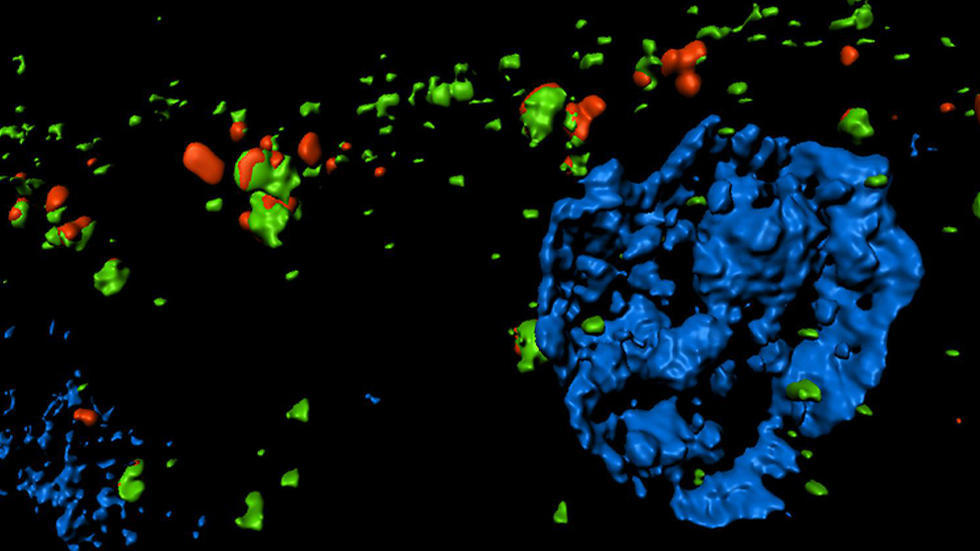Research identifies key factor leading to cell cycle arrest and fibrosis production in the kidney

A new study of how scar tissue is produced in the kidneys has identified potential culprits and promising targets for intervention. The study, published in Science Translational Medicine, was led by HSCI scientists based at Brigham and Women’s Hospital.
Background
Chronic kidney disease is a growing global health concern, affecting about 10 percent of the world’s population. A final, common pathway in chronic kidney disease is fibrosis, the formation of internal scar tissue, which can cause devastating effects. In the kidneys, it can ultimately lead to end-stage kidney failure.
Recent research has shown that after acute kidney injury, the kidneys often fail to repair themselves completely. Kidney cells may get stuck during the point in the cell cycle where they release pro-fibrotic factors.
What the study found
HSCI faculty member Joseph Bonventre and his colleagues identified key factors involved in this cell cycle arrest and provided insight into its consequences. Based on these findings, they identified a structure within the cell that is involved in the cell cycle arrest and proposed new therapeutic targets for kidney fibrosis.
“As a disease mechanism, fibrosis may account for more deaths than any other,” said Dr. Bonventre, who is chief of the Division of Renal Medicine at Brigham and Women’s Hospital. “Our lab has been studying acute and chronic kidney injury and fibrosis for many years. We’re now focused on the transition from acute to chronic kidney disease and what leads to fibrosis in the kidneys.”
How they did it
Bonventre and colleagues studied the transition from acute to chronic kidney disease in mice, using extracted epithelial cells and analyzing which genes were active when.
They observed that as kidney fibrosis progresses, a critical compartment is formed within kidney cells: the rapamycin-autophagy spatial coupling compartment, called TASCC. (TASCCs are also formed during liver fibrosis.)
The scientists found that cyclin G1 (CG1), a protein involved in regulation of cell cycle arrest, also plays a role in triggering the formation of TASCCs.
Their experiments showed that in the presence of TASCC, the secretion of fibrosis-promoting factors increased. Blocking the formation of TASCCs reduced the severity of kidney fibrotic disease progression in preclinical models.
The studies in mice were complemented by research in a group of patients suffering from chronic kidney disease who had developed progressive fibrotic lesions.
Compared to control subjects, the kidney tissue of these patients had more kidney cells arrested in the G2/M phase of the cell cycle. These cells contained TASCCs. Further supporting the significance of this link, TASCC-containing cells were also found in patients with acute kidney injury.
Why it matters
By identifying a mechanism that triggers the formation of a compartment in kidney cells that facilitates the secretion of pro-fibrosis factors, the scientists have discovered a promising target for developing new therapies for patients with chronic kidney disease.
Discover moreThis article originally appeared on the Brigham and Women's Hospital website. [Read the canonical version] Source publicationCanaud G, et al. (2019) Cyclin G1 and TASCC regulate kidney epithelial cell G2-M arrest and fibrotic maladaptive repair. Science Translational Medicine 11: eaav4754. Published online 23 January; doi: 10.1126/scitranslmed.eaav4754 ContributionsFormer members of the Bonventre lab, including Guillaume Canaud, M.D., Ph.D. (currently a faculty member at INSERM Necker-Enfants Malades Hospital in Paris), Craig Brooks, Ph.D. (Vanderbilt University), and Seiji Kishi, M.D., Ph.D. (Kawasaki Medical School) and other authors played important roles in this work. FundingFunding for this work was provided by National Institutes of Health (R37DK039773, R01DKD072381, K01DK099473 and P30 DK114809), Safra Foundation, Philippe Foundation Inc., Bettencourt Schueller Foundation, Société Française de Néphrologie, Emmanuel Boussard Foundation (London, UK), Day Solvay Foundation (Paris, France), Assistance Publique- Hôpitaux de Paris, University Paris Descartes, Research Fellowship from Sumitomo Life Welfare and Culture Foundation, Japan and Grant in Aid for Scientific Research. Bonventre is a co-inventor on KIM-1 patents assigned to Partners Healthcare. He is an advisor for Boehringer Ingelheim, BioMarin, Takeda, and Lilly and receives grant support from Boehringer Ingelheim unrelated to this work. He holds equity in Goldfinch Bio, Theravance, Sentien, and Rubius. |
